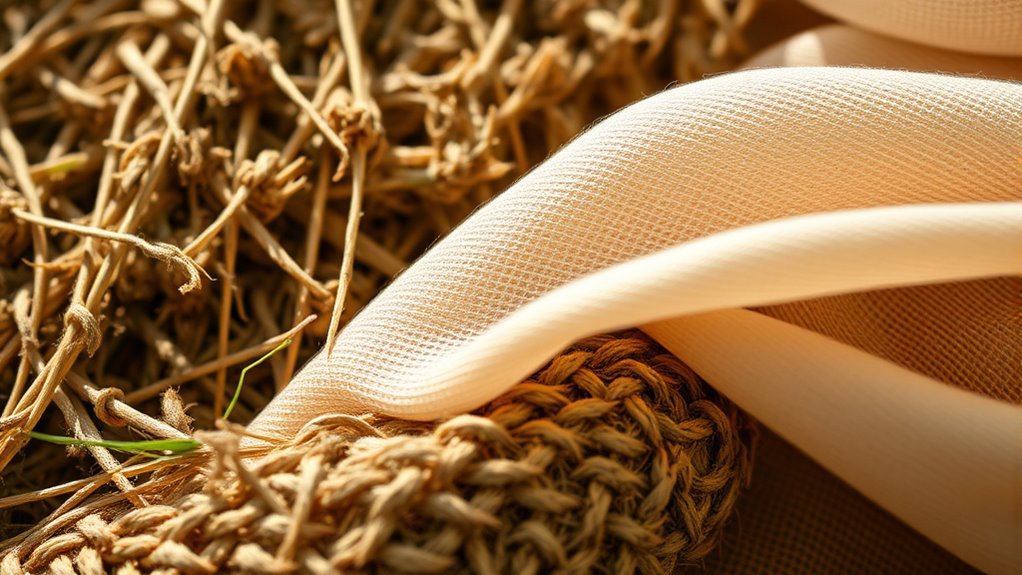Biodegradable textiles like hemp, organic cotton, and Tencel break down naturally, reducing environmental pollution caused by synthetic fibers. Hemp grows quickly without pesticides, while Tencel, made from eucalyptus using a eco-friendly process, decomposes faster and easier to recycle. Opting for these materials with minimal chemical treatments guarantees less toxic residue and supports sustainability. To discover how these fabrics can transform your impact on the planet, continue exploring the options available.
Key Takeaways
- Biodegradable textiles like hemp, organic cotton, and Tencel decompose naturally, reducing environmental pollution caused by waste.
- Hemp is a sustainable crop that grows quickly without pesticides, requiring minimal water and chemicals.
- Tencel is produced via a closed-loop process that recycles water and solvents, ensuring biodegradability and eco-friendliness.
- Minimizing chemical treatments and using natural dyes enhance the biodegradability and safety of textile products.
- Choosing biodegradable fibers supports sustainable fashion by lowering microplastic pollution and reducing landfill waste.

Have you ever wondered what happens to your clothes after you throw them away? Most likely, they end up in a landfill or are incinerated, contributing to pollution and environmental harm. Traditional textiles are often made from synthetic fibers, which are derived from petrochemicals and are not biodegradable. These fibers are durable and inexpensive, but their resilience comes at a cost. They don’t break down easily in the environment, lingering for decades, and releasing microplastics that pollute our water and soil. Many of these synthetic fibers undergo chemical treatments during manufacturing to enhance properties like stretch, colorfastness, or water resistance. While these treatments improve the fabric’s appearance and longevity, they also make recycling or composting the textiles more difficult. The chemicals can be toxic, leaching into ecosystems and posing health risks to animals and humans alike. Understanding the impact of synthetic fibers and chemical treatments highlights why the shift toward biodegradable textiles is so essential. Unlike synthetic fibers, biodegradable textiles are designed to break down naturally through microbial activity, leaving no harmful residues. Natural fibers like hemp, organic cotton, or Tencel, a fiber made from sustainably grown eucalyptus trees, decompose much faster and more completely. These materials are often processed without harsh chemical treatments, making them safer for the environment. Hemp, for example, is a highly sustainable crop that grows quickly without needing pesticides or excessive water. It produces fibers that are not only biodegradable but also incredibly strong and versatile. Tencel, on the other hand, is manufactured using a closed-loop process that recycles water and solvents, minimizing environmental impact. Biodegradability is a key factor in determining how quickly textiles return to the earth and how much environmental harm they cause. The move toward biodegradable textiles involves more than choosing natural fibers; it also requires reducing or eliminating chemical treatments that hinder decomposition. Many conventional textiles are finished with dyes, water repellents, or flame retardants that can delay or prevent biodegradation. In contrast, eco-friendly textiles are often dyed with natural or low-impact dyes, and their chemical treatments are carefully selected to be biodegradable or absent altogether. This ensures that once you discard these clothes, they begin to break down naturally, returning to the earth without leaving toxic residues. As a conscious consumer, understanding the significance of these differences can guide you toward more sustainable choices. Choosing biodegradable textiles made from hemp, Tencel, or organic cotton with minimal chemical treatments helps reduce environmental pollution and supports a healthier planet.
Frequently Asked Questions
How Long Does It Take for Biodegradable Textiles to Decompose?
Biodegradable textiles typically decompose within a few months to a couple of years, depending on environmental factors. If you leave them in a compost or natural setting with proper moisture, temperature, and microbial activity, they break down faster. However, in landfill conditions, the decomposition timeline can extend beyond several years due to limited oxygen and microbial activity. So, environmental factors play an essential role in how quickly these textiles decompose.
Are Biodegradable Textiles More Expensive Than Conventional Fabrics?
You’ll find that biodegradable textiles are often more expensive than conventional fabrics due to higher production costs and eco-friendly materials. However, the cost comparison varies depending on the specific textile and market availability. While eco-conscious consumers might pay a premium, increasing demand is gradually making biodegradable fabrics more accessible and affordable, encouraging broader adoption. To get the best deal, compare options and look for brands emphasizing sustainable, eco-friendly practices.
Can Biodegradable Textiles Be Recycled After Use?
Yes, biodegradable textiles can often be recycled after use, but recycling challenges may arise due to fiber longevity differences and complex material compositions. You might find that some fibers break down faster, making recycling more difficult, or that mixed fibers complicate the process. Despite these challenges, recycling remains possible and helps reduce waste, but it requires specialized processes to make certain the fibers retain their quality and biodegradability.
What Environmental Benefits Do Biodegradable Textiles Offer?
Think of biodegradable textiles as nature’s compost, returning to the earth instead of lingering in landfills. They offer significant environmental advantages by reducing waste and lowering pollution. Their biodegradable impact means they break down naturally, minimizing harm to ecosystems and conserving resources. By choosing these textiles, you help promote sustainability, decrease carbon footprints, and support a healthier planet for future generations.
Are There Any Health Risks Associated With Biodegradable Textile Fibers?
You might wonder about fiber safety and allergen concerns with biodegradable textile fibers. Generally, these fibers are safe, but some people could experience allergic reactions to natural fibers like hemp or certain processing chemicals. it is crucial to check for allergen information and choose certified, non-toxic options. Overall, biodegradable fibers tend to be safe, but staying aware of your sensitivities helps you avoid potential health risks.
Conclusion
Think of biodegradable textiles as the gentle roots of a thriving garden, quietly returning to nourish the earth after their purpose is fulfilled. By choosing fibers like hemp and Tencel, you become a steward of this delicate ecosystem, ensuring it flourishes for generations. Every garment you wear is like planting a seed—hopeful, sustainable, and kind to our planet. Embrace these textiles, and watch as your choices help weave a greener, more vibrant future.









